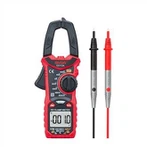How to improve the measurement accuracy of infrared thermometer
Temperature is a physical quantity that measures the hotness and coldness of an object. It is a very common and important thermal parameter in industrial production. Many production processes require temperature monitoring and control. Whether the operating status of certain equipment is normal will be obviously reflected in the temperature, so that the operating status and faults of electromechanical equipment can be understood based on changes in temperature values. Temperature cannot be measured directly, it must be measured indirectly with the help of certain physical properties of the object. Table 1 lists commonly used temperature measurement methods and characteristics. Among them, infrared temperature measurement, as a commonly used temperature measurement technology, has obvious advantages.
1. Characteristics of infrared thermometer
Infrared temperature measurement is a non-contact temperature measurement technology. It has the following characteristics: (1) Non-contact measurement; (2) Fast response time, a few tenths of a second; (3) High sensitivity, temperature resolution of 0.1°C and Millimeter-level spatial resolution; (4) Wide temperature measurement range, from tens of degrees below zero to thousands of degrees. Since there is no need to contact the object being measured during measurement, the temperature of objects that are difficult to reach can be accurately detected without contamination or damage to the object being measured. The portable red J'I, N thermometer is easy to carry around and easy to operate. It can be used for target temperature detection in many aspects. It is widely used in equipment fault diagnosis, HVAC, railways, petroleum, chemical industry, metallurgy, glass, and metal processing. and other fields. This article starts from the basic principles of infrared temperature measurement and focuses on how to improve the accuracy of infrared thermometers.
2. Basic principles of infrared temperature measurement
Infrared ray is an invisible light that has a strong thermal effect. Any object in nature can radiate infrared rays as long as its temperature is above zero (-273~C). Using the infrared radiation of an object to measure the temperature of a substance is infrared thermometry. The basic principle and basis for infrared temperature measurement is the Stephan-Piltzmann law. This law gives the relationship between material temperature and radiant energy: E - radiant power of the object (W/m); 仃 - specific emissivity of the material; s - Stephen-Biltzmann constant (5.67 X 10 W/(m ·K )); The maximum temperature of the object (K). It can be seen from the above formula: According to the radiant power emitted by the object (measured by the detector) and its specific emissivity (obtained from the table or experiment), its temperature can be calculated according to the above formula. 3 How to Improve the Accuracy of Infrared Thermometers
3.1 Determine the temperature measurement range
Temperature measurement range is the most important performance indicator. For example, Raytek's product coverage range is from -5O℃ to 3000℃, but this cannot be accomplished by one type of infrared thermometer. Each type of thermometer has its own specific temperature measurement range. Therefore, users should have a general understanding of the temperature to be measured before they can decide which type of thermometer to use. The measured temperature range must be considered accurately and comprehensively, neither too narrow nor too wide. The narrower the temperature measurement range of the thermometer, the higher the resolution and accuracy of the output signal for monitoring temperature, and the more accurate the temperature measurement. If the temperature measurement range is too wide, the temperature measurement accuracy will be reduced and the error will be larger. Common material emissivity






